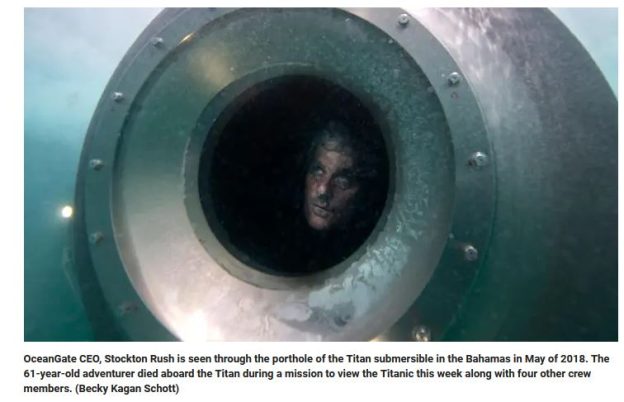Truth to tell, the Titan resembled nothing so much as a ‘Hold My Beer’ contraption, assembled with parts as good as you get from Home Depot
…a carbon fiber cylindrical hull, topped and tailed with Titanium hemispheres. Titanium glued to carbon fiber with an epoxy-type resin and fastened with bolts: Just image the iffy quality of joiners that meld dissimilar materials under the pressure of 376 atmospheres! ~ilana
NEW COLUMN is “Subpar Submersible: Woke Will Implode, On Land And Underwater.” It is a feature on WND.COM, The Unz Review and The New American
You can read it now on IlanaMercer.com.
Excerpt:
… In hiring, Mr. Rush clearly prized the cool quotient over cool-headed competency.
OceanGate—which “sounds like a scam waiting to happen,” quipped engineer podcaster “Two Bit da Vinci”—was an outfit out of Everett, Washington. It had been aggressively marketing the Titan as a vessel fit for deep-sea exploration. Yet, rather than use a metal that withstands compression; for the main composite of their subpar submersible, the anti-white ageist brainiacs of OceanGate chose carbon fiber.
Some reports contend that “NASA’s Marshall Space Flight Center in Alabama helped build the lost Titanic submersible.” Charitably put, it is unclear how involved NASA engineers and the Washington State academic dumbassery were with Titan’s cool kids. Disavowals from NASA, Boeing and the University of Washington notwithstanding; on this count, I intuitively believe Titan CEO Rush. Daily Mail alleges that Rush “had hired interns from Washington State University who … boast[ed that] … a PlayStation remote was used to run the Titan.”
Rush chose to use consumer electronics for a high-reliability application! In all likelihood, however, the Sony PlayStation controller would have been the more reliable node in the Titan’s intern-devised electrical network.
For it is quite clear that systemic, institutional rot now defines American institutions, commercial, civic and state. My 2011 book, Into The Cannibal’s Pot; Lessons for America From Post-Apartheid South Africa, warned, by way of an example, that ridding Eskom, a South African electricity public utility that once helped power the continent, of the best engineers—experienced white men—would plunge South Africa into darkness. So it has.
What is also clear is that the mission of the white-hating Deep-Sea techies of the Titan is shared by Deep Tech (aka Big Tech) in general: marginalize whites and the attendant issue of competency. …
… Contra Stockton Rush, when engineers in-the-know speak of the Titan; they speak of a lack of mechanical tests, an absence of a locator beacon; an indifference to the operational lifetime—namely cumulative, structural fatigue—of such an inherently rickety tube; all compounded by the submersible’s primary composite: carbon fiber. “Exotic in the world of materials,” carbon fiber is unsuited to the task of withstanding immense pressure.
… THE REST. READ “Subpar Submersible: Woke Will Implode, On Land And Underwater” on WND.COM, The Unz Review and The New American.




